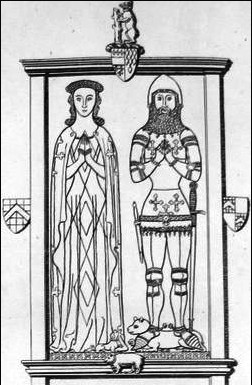Manor
The estates of the Benedictine Pershore Abbey included lands at Beoleahe from the 10th century at the latest, when Edgar the Peaceful restored them to the monks in AD 972. [5] The Domesday Book of 1086 records that the abbey held 21 hides of land at Beolege and Yardley. [5] An ancient castle, of which very slight traces remain, belonged successively to the noble families of Mortimer, Beauchamp, and Holland. [6] Roger Mortimer (died 1214), Lord of Wigmore first appears in the pipe roll for 1174–1175, when he owned land in Shropshire and Worcestershire, and his daughter Joan Mortimer (died 1225) married Walter de Beauchamp of Elmley, Worcestershire, according to the Annals of Worcester. [7] In 1378 John Holland, First Duke of Exeter and Earl of Huntingdon was granted lands by his half-brother King Richard II which included Buley Castel, this part being forfeited on 14 April 1385, though other lands were restored to him elsewhere. [8] The de Beauchamp family of Elmley Castle, ancestors of William de Beauchamp, 9th Earl of Warwick, were mesne lords of the manor from the 12th century until about 1265, when they acquired the overlordship (superiority) from the abbey. [5] In the 13th century the toponym was variously rendered Boleye, Beleg or Buley. [5] The superiority of Beoley descended with the de Beauchamps until the death of Henry de Beauchamp, 1st Duke of Warwick in 1446, when it passed to his daughter Elizabeth, wife of George Nevill, 1st Baron Latimer. [5] It is said to have remained with the Latimers until John Nevill, 4th Baron Latimer sold it in 1549. [5]
William Sheldon of Abberton, however, must have held a good part of the parish by feu, as he was established at Balford Hall in Beoley in the reign of Edward IV (1460–1483). In addition, he bought Benyt's Place in that parish in 1488. Sheldon supported the Yorkists at the battle of Bosworth in 1485, and as a result of the definitive Lancastrian victory there he was deprived of his property, but it was restored to him before he died in 1517. [9] In his Inquisition Post Mortem, held at Pershore, it was said that Sheldon owned Balford Hall and seven other houses and 460 acres (186 ha) of land in Beoley, and more elsewhere in Worcestershire and Warwickshire. In his will he made bequests to the churches at Beoley and Abberton and to Pershore Abbey. [10]
Sheldon was succeeded at Beoley by his son Ralph (died 1546), who was married to Philippa, daughter of Baldwin Heath of Ford Hall, Wootton Wawen. [5] Ralph was imprisoned in the Marshalsea in 1580 for recusancy, but released on medical grounds. [5] Ralph was succeeded at Beoley by his eldest son, William (c. 1500–1570), who possessed the manors of Weston, Warwickshire, Abberton (jointly with his brother Francis), and by then virtually the whole parish of Beoley: some 4000 acres (over 1600 ha). He was Receiver at the Court of Augmentations, Knight of the Shire for Worcestershire, and Sheriff of the same county. Around 1534, William Sheldon purchased 2,000 acres (809 ha) of land at Skilts, between Beoley and his mother's home Ford Hall – lands which had been a grange of Studley Priory. His magnificent tomb is in Beoley parish church.
William Sheldon was succeeded by his son, another Ralph Sheldon (1537–1613), who was married to Anne, daughter of Sir Robert Throgmorton of Coughton, who had attended the reception of Anne of Cleves. A Roman Catholic, Ralph Sheldon was a courtier at the Court of Queen Mary, and for a time a courier for Mary Queen of Scots between her place of confinement and Scotland. He is frequently mentioned in State Papers as a recusant. In 1594 there is a reference to an alleged premeditated rebellion in North Wales, "the chiefest aid for which is to come from Ralph Sheldon," and to his sending an emissary to Louvain "with letters to Cardinal Allen". He is said to have been responsible for the construction of the manor house at Weston Park in Warwickshire, another Sheldon estate in Long Compton parish. He was succeeded by his eldest son and heir, Edward (1561–1643), also a Royalist. In August 1636, Charles I of England visited Warwick, and a day or two later went on "to Weston at Mr. Sheldon's house with great delight".
Edward's son and heir, William Sheldon of Beoley (1589–1659), always resided at Weston Park, where he died. In 1611, he married Elizabeth, daughter of the recusant William Petre, 2nd Baron Petre. [11] Considered "a man of literary taste", Sheldon was a Royalist and at various times during the early years of the Civil War he was, in his turn, harassed as "a Popish delinquent".
After the Restoration of the Monarchy in 1660, Beoley was restored through Richard Sheldon to William's son, the antiquary Ralph Sheldon (1623-1684). He was married to Henrietta Maria, daughter of Thomas, 1st Viscount Savage, but had no issue. [5] [12] Beoley then passed to a first cousin once removed, Ralph Sheldon, Lord of Beoley and Weston (1653–1720), who was married to Mary Anne, daughter of John Elliot of Gatacre Park, Shropshire. His estates passed to his eldest son and heir, Edward (1679–1746) and then to the latter's eldest son William (1715–1780). His son in turn, Ralph Sheldon, inherited Beoley in 1780, but by 1788 it was said to be heavily mortgaged and he sold the manor to a Thomas Holmes. [5] Holmes separated Beoley Hall (see below) and 300 acres (120 ha) of land from the rest of the manor and sold off both to separate buyers. [5]














